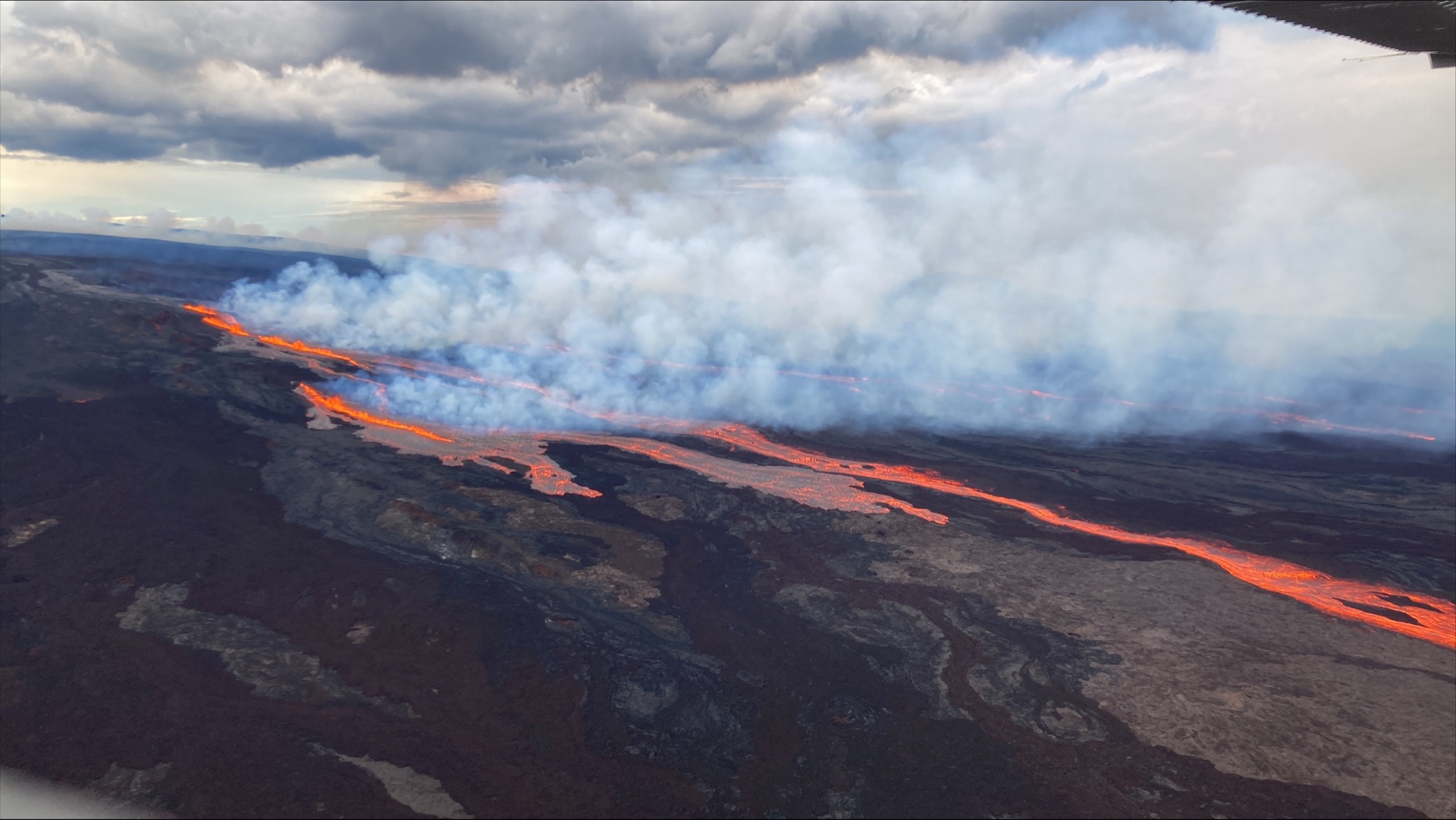What we’re watching: Weekly disaster update, November 28

We know all too well that disaster can strike at any time, in any place in the world. Some disasters make headlines; others do not. Here at the Center for Disaster Philanthropy, we keep an eye on the status of disasters worldwide and compile a list of the ones we’re tracking weekly, along with relevant disaster-related media coverage.
Here’s what we’re watching for the week of Nov. 28, 2022.
New or Emerging Disasters
Volcano – Hawaii: The largest volcano in the world – Mauna Loa – began to erupt on Nov. 28 (11:30 p.m. HST) for the first time in 38 years. Although there is no current lava flow risk, the eruption has triggered more than two dozen earthquakes of 2.5 magnitude or higher. Additionally, authorities advised residents to be aware of the impact of falling ash. Mauna Loa is 13,679 feet above sea level, much bigger than the Kilauea volcano, which destroyed 700 homes in a 2018 eruption. No evacuations have been issued yet, but some residents are evacuating to local shelters.
Measles – Worldwide: According to a joint publication from the World Health Organization (WHO) and the United States Centers for Disease Control and Prevention (CDC), there has been a steady decline in measles vaccination coverage since the COVID-19 pandemic started:
“In 2021, a record high of nearly 40 million children missed a measles vaccine dose: 25 million children missed their first dose and an additional 14.7 million children missed their second dose, a joint publication by reports. This decline is a significant setback in global progress towards achieving and maintaining measles elimination and leaves millions of children susceptible to infection.”
In 2021, there were an estimated 128,000 deaths and nine million cases worldwide, compared to 60,700 deaths and 7.5 million cases in 2020.
Avian Flu – United States: If your Thanksgiving turkey and deviled eggs cost more last week, you can blame the Avian flu. The U.S. had its deadliest outbreak this year, with more than 50.54 million birds, including chickens and turkeys, killed. This is just slightly higher than 2015’s outbreak which killed 50.5 million birds. Wild birds such as ducks are responsible for both outbreaks – 30% of cases in 2015 were traced to them and 85% in 2022. Britain and Europe are also facing record highs in cases of avian flu, with some grocery stores in England rationing egg purchases because of shortages.
Previous/Ongoing Disasters
Earthquake – Indonesia: The Cianjur region of West Java was hit by a 5.6-magnitude earthquake at 1:21 a.m. ET on Nov. 21. As of Sunday, Nov. 27, at 5 p.m. local time, the number of those killed in the earthquake was at 321, with 11 people still missing. More than 100 children under 15 were among those killed.
The head of Indonesia’s disaster management agency (BNPB), Suharyanto, stated in a press conference that “the number of refugees was 73,874 people, with details of 33,713 male refugees and 40,161 female refugees. Meanwhile, 27,434 houses were heavily damaged for infrastructure, 13,070 moderately damaged and 22,124 houses lightly damaged, bringing the total damaged houses to 62,628 houses.”
RSV/Flu – United States/Canada: The surge of RSV (respiratory syncytial virus) and flu cases in the U.S. and Canada is not decreasing, with hospitals in both countries well beyond capacity. Some medical experts fear a “tripledemic” when COVID-19 is added to the mix. Many communities are now setting up field hospitals or moving pediatric cases into adult hospitals (adult hospitals did in reverse during COVID-19 surges) to deal with the overflow of patients.
The Hill reported, “According to Centers for Disease Control and Prevention data, the hospitalization rate in all kids for the week of Nov. 12 peaked at 17.5 out of every 100,000, a rate that was twice as high as any other season on record.” As an indicator of the extent of the crisis, the pediatric ICU at Boston’s Mass General for Children has three children waiting for an ICU bed for every child discharged. A Tylenol shortage is adding to the challenge in Canada and U.S. border towns.
Cholera – Haiti: As of Nov. 20, the cholera outbreak in the greater Port-au-Prince area had grown to 11,039 suspected cases, including 938 confirmed cases, 9,344 hospitalized suspected cases and 202 registered deaths. These represent significant increases with a 22% growth in suspected cases and 15% growth each in confirmed cases and deaths compared to the update less than a week prior. The case fatality rate is 2% among suspected cases. Haiti is just one of several countries with cholera cases or outbreaks, including Cameroon, Nigeria, Syria and Pakistan. Vaccine shortages have led to rationing the vaccines to a single dose instead of a two-dose regimen.
In addition to the disasters listed above, we are actively monitoring the following disasters or humanitarian emergencies. For more information, see the relevant disaster profiles, which are updated regularly.
- Afghanistan Humanitarian Crisis
- COVID-19 Coronavirus
- Horn of Africa Hunger Crisis
- 2022 North American Wildfires
- 2022 Pakistan Floods
- Ukraine Humanitarian Crisis
Complex Humanitarian Emergencies – Cameroon
Many places worldwide are experiencing emergencies caused by conflict, climate change, drought, famine, economic challenges and other conditions that combine to create a complex humanitarian emergency (CHE). CDP maintains complete profiles on several CHEs, and what CDP considers Level 1 CHEs are profiled in this weekly blog post and tracked.
Three complex, protracted humanitarian crises in Cameroon are affecting more than 90% of the country. These are caused by continuous violence in the Lake Chad basin, insecurity in the North-West and South-West regions, and crises in Nigeria and Central African Republic (CAR). As of Oct. 31, Cameroon is host to more than 493,972 refugees, including 353,362 from the CAR and 138,107 from Nigeria. In addition, there are 597,909 internally displaced people (IDPs) because of the insecurity in the North-West and South-West regions, with nearly 80,000 seeking refugee status in Nigeria.
The conflict in Nigeria has both increased the number of refugees in Cameroon, but also spread violence into Cameroon’s Lake Chad region leading to nearly 400,000 IDPs. After Nigeria, Cameroon suffers the most from the violence and insecurity caused by Boko Haram. This includes kidnapping of students and teachers, and targeting of health care workers and clinics.
Flooding that started in the Far North region in August affected 150,000 people, as of the beginning of November. At least 18,000 homes have been destroyed and over 125 schools were flooded. Latrines and water access have also been disrupted. There has been significant damage to agricultural crops and cattle. Access to the area is reduced because of the floods, combined with hippos in the waterways. A landslide occurred on Nov. 27, in Yaounde Capital City (southern Cameroon), leading to at least 14 deaths in Damas District.
All these factors, combined with the socioeconomic and health impacts of the COVID-19 pandemic, have caused a deterioration of the well-being and living standards of people living in Cameroon. Currently, nearly four million people are identified as requiring humanitarian assistance. As of Nov. 28, donors had funded only 39.8% of Cameroon’s Humanitarian Response Plan requirements.
General price inflation has increased since the start of the war in Ukraine. The general inflation rate was 6.1% as of August 2022, which is more than double the Central African Economic and Monetary Community zone inflation threshold of 3%. This has had a significant impact on food access and pricing, leading many to exhaust savings and take on debt to feed their families.
Current needs include protection, shelter, refugee support, health, food security, WASH, education and nutrition.
In a piece of positive news, Cécile Bibiane Ndjebet, received an Inspiration and Action award from the UN Environmental Programme, which recognized “her work in repairing damage caused by chopping down forests, draining wetlands, and polluting rivers at unstainable rates.” Ndjebet, is the co-founder of Cameroon Ecology and President of the African Women’s Network for Community Management of Forests.
What We’re Reading
- Ian was one of the most lethal hurricanes in decades. Many of the deaths were preventable. – NBC News: Coming 17 years after Hurricane Katrina, Hurricane Ian’s death toll shows that many of the lessons about preparing communities for storms have not yet been learned, or at least implemented. An investigation into the storm “exposed shortcomings in how local governments communicate the risk posed by hurricanes, decide when to order evacuations and identify and help the most vulnerable residents.”
- COP27: Diplomatic baby steps amid mounting humanitarian crises – The New Humanitarian: “Climate justice played a central role at COP27, where the snail’s pace of progress on addressing the climate emergency once again stood in stark contrast to the realities on disaster front lines.”
- Three ways in which cities can spur development and climate change adaptation – International Growth Centre: “Cities in sub-Saharan Africa and South Asia are among the most vulnerable to the effects of climate change due to their geographic features and low income per capita. Many of the challenges related to sustainable urbanisation in poor countries can be overcome by getting the city development model right, and by focusing on pursuing development and adaptation goals in tandem.”
- The fullest investigation of the massive Hunga Tonga-Hunga Ha’apai eruption to date – The Watchers: “In January 2022, Hunga Tonga-Hunga Ha’apai (HT-HH) emitted the biggest atmospheric explosion recorded on Earth in more than 100 years. Several months after the eruption, a New Zealand-led team has completed the fullest investigation to date into the eruption of this underwater Tongan volcano.”
- The ‘alarming consequences’ of drought on supply chains – Supply Management Magazine: A new report from the World Economic Forum found that droughts around the world disrupted billions of dollars of cargo this year. The “economic damage from droughts rocketed by 63% in 2021 compared to the 20-year average” and many international trade routes including the Mississippi, the Rhine and the Yangtse River Basin became impassable in 2022.
- The limits of loss and damage: A cautionary tale from Pakistan – The New Humanitarian: This article, an opinion column from a United Nations staffer, explores the impact of prior systemic exclusion during the floods in Pakistan (the author’s home country). She describes the ways women and people living in poverty have been ignored both before and in the aftermath of the floods, resulting in poor health outcomes for women and children.
We’ve reached the end of the Atlantic Hurricane season, with no activity predicted this week by the National Hurricane Center. While it is possible for hurricanes to occur in the Atlantic basin during December, it is very rare. Before the season ends, refresh your memory (and share with your kids) with this Fun Facts from Hamlet the Hamster video looking at facts about hurricanes.
